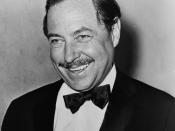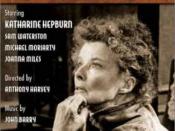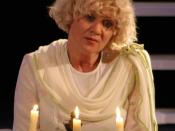Dark and dim lights, working in coordination with the actors, the music, and other elements is what creates the unrealistic atmosphere and setting for The Glass Menagerie.
The theme of memory is prevalent. To reinforce the concept the reference of "turgid smoky red glow" as well as "deep blue dusk" call forward the cloudy feeling that is Tom's memory. The stage production of The Glass Menagerie reminds one of cinema. Whereas in film, a close up can be used, as replacement Tennessee Williams use "shafts of light" that are used to bring the illuminated center. It would is apparent that the frequent movie going character of Tom is based on Tennessee Williams, and as such has taken in cinematic concepts.
The use of music to emphasize the dramatic moments on stage as well as the overall atmosphere reminds me of film. The screen is reminiscent of the dialogue in silent films, and then there is what I view to be most obvious, it is the use of lighting; "Shafts of light", as Williams writes in his production notes "are focused on selected areas or actors, sometimes in contradiction to what is the apparent center."
This reminds me of how close-ups shots in a film can reach the same effect. I am going to discuss, in the most simple of terms. How light is used, to highlight he action and drama that takes space on the stage, as well as the atmosphere as well as the overall effect of the scenes. I often quote from the production notes.
Soon into the reading of the play, even without the production notes explicitly mentioning, we are told directly that "the play is a memory" and in "Being a memory play, it is dimly lighted, it is sentimental, it is not realistic".


